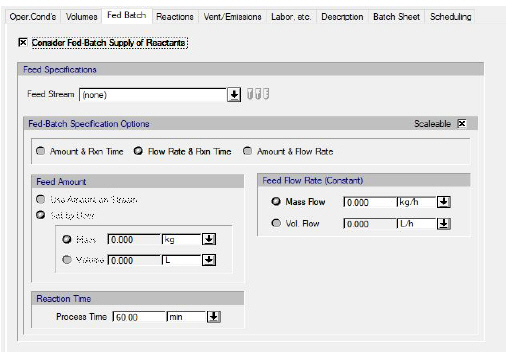

The following table shows a brief description of the variables appearing in this tab. The table also displays their default values and their generally acceptable range:
|
Variable |
Default Value |
Range |
|
|
||
|
○ Consider Fed-Batch Supply of Reactants |
No |
Yes/No |
|
○ Feed Stream |
<none> |
Any Input Stream |
|
○ Scalable |
Yes |
Yes/No |
|
○ Use Amount Available on Feed Stream |
No |
Yes/No |
|
◙ Mass (kg) |
0.0 |
Positive |
|
◙ Volume (L) |
0.0 |
Positive |
|
◙ Constant Mass Flow (kg/h) |
0.0 |
Positive |
|
◙ Constant Vol. Flow (L/h) |
0.0 |
Positive |
|
◙ Process Time (min) |
60.0 |
Positive |
|
● Key Reactant Concentration at Reaction Start (g/L) |
100.0 |
Positive |
Symbol Key: ○ User-specified value (always input); ● Calculated value (always output); ◙ Sometimes input, sometimes output
Specify whether there is simultaneous feed of material during the reaction, and select the feed stream. Then specify either the stream flowrate (mass/volume) or amount of material fed per cycle (mass/cycle) so that the flowrate is calculated. In all cases it is assumed that the feeding of material during the reaction is at a constant rate. The required flow of the feed stream is propagated backwards, through the network of connectivity.
If you check the ‘Scalable’ option, then the amounts you specify will be scaled with process throughput. That is if you choose to adjust the process throughput by a factor the user-specified flowrate or amount per cycle will also be adjusted by the same factor.
By selecting the Constant Reactant Concentration option the user can keep the concentration f a key reactant constant (equal to its initial value) by adjusting the flow rate of the fed-batch stream (variable feeding rate). This option is only available in batch kinetic reactions and fermentations.